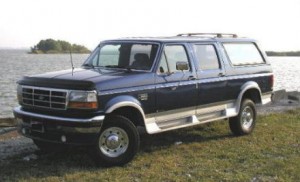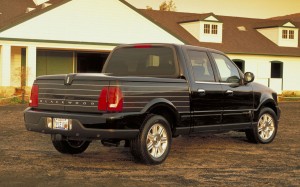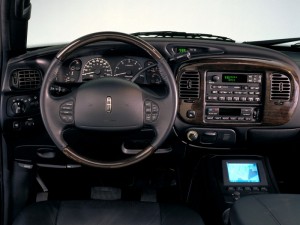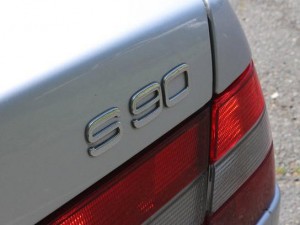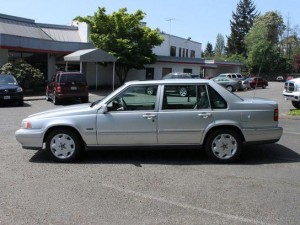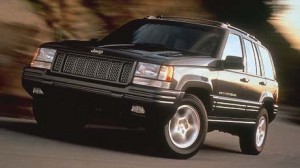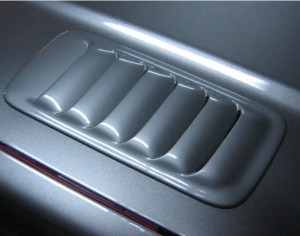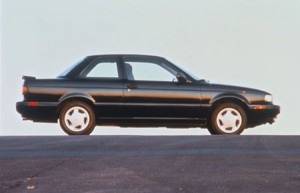Ford C-150/C-350 Centurion: It Exists
Posted by Doug DeMuro in It Exists on | 12 comments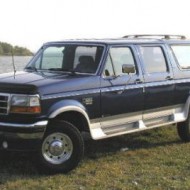
I recently learned about the Ford C-150 and C-350 Centurion from a reader. It’s good that I didn’t know about it before, because I probably would’ve purchased one, and then complained when it drove like crap.
Although there isn’t much info on the Web about these cars, here’s what I’ve gathered. Centurion is a coachbuilder in Michigan. The Ford Bronco is a vehicle. Are you with me so far?
In the mid-1990s, Ford only made a two-door Bronco. This satisfied most Bronco buyers, such as OJ Simpson. But there was apparently public demand for a four-door version, which is where Centurion came in. They would buy Broncos from Ford, stretch them, and add doors.
The result was the Centurion C-150 and the Centurion C-350. The 150 was, of course, light duty, while the 350 was the heavy-duty model. They all had three rows. Apparently there were also Centurion F-150s, but I can’t find any information about them, largely because “FourDoorBronco.com” – agreed to be the web’s number one source of information about these trucks – is down for maintenance.
Personally, I find the Centurion trucks rather handsome in a “I’ve never seen this before and it doesn’t look bad” sort of way. Ford probably did too, because the Bronco died in 1996 and the Expedition came out in 1997, thus killing the Centurion forever.
Today, Centurion’s website is down and the trucks only exist with inoperable transmissions on faraway Craigslists.
Lincoln Blackwood: It Exists
Posted by Doug DeMuro in It Exists on | 18 comments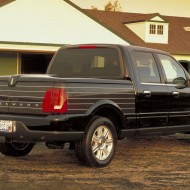
In the late 1990s, Lincoln beat Cadillac to the full-size luxury SUV punch by releasing the Navigator just before Cadillac debuted the Escalade. The vehicle you see here is an attempt at achieving a second such release date victory.
The Lincoln Blackwood was offered in the 2002 and 2003 model years with a retail price of around $53,000. Of course, not one Blackwood changed hands anywhere that figure, because the truck was fraught with shortcomings.
In theory, the idea of the Blackwood makes perfect sense. I once read Lincoln decided to build the truck after discovering some absurd number of their customers – like half – also have a pickup truck in the garage. No, the problem wasn’t in the concept: it was in the execution.
For one, every single Blackwood was rear-wheel drive. There were no exceptions. This was an odd decision, mostly because a lot of those Lincoln owners probably had a pickup solely because it was capable of things their Town Car couldn’t manage. The Blackwood, unfortunately, wasn’t capable of much.
That includes hauling. Every single Blackwood was fitted with a tonneau bed cover, which was power-operated and very slick. Unfortunately, this transformed the truck into little more than a pickup sedan. Worse, the truck’s 1,200-pound payload capacity meant that four adults in the cabin ate up half of the Blackwood’s hauling abilities.
The Blackwood had other issues. Namely: it had strips of black wood on the rear quarter panel. Except that closer inspection revealed they weren’t wood, but rather paint that vaguely resembled wood. And I stress vaguely. Also, the Blackwood’s “high-tech” navigation system was fitted deep in its center console and offered a screen no larger than a modern iPhone.
The Blackwood went out of production after just 3,300 units. Lincoln later tried the full-size truck market again with the Mark LT, but was again rebuffed after poor sales. Yes, it exists. But we probably wish it didn’t.
Volvo S90: It Exists
Posted by Doug DeMuro in It Exists on | 23 comments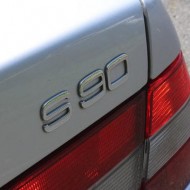
I think, if you asked around, you’d find that this site really needs some more Volvo content. And so I’ve decided to provide that in the form of a short piece on Volvo’s forgotten model: the S90.
I know what you’re thinking: there is no S90! You’re crazy! Also, this site does not need any more Volvo content! You’re probably right about that last bit. I’ve covered a lot of Volvo stuff here, largely because they build loads of very unusual cars. Like the S90.
OK, so you’ve heard of the S40, and the S60, and the S80. You had forgotten about the S70, but now you sort of remember that, too. So what the hell was the S90?
In the late 1990s, Volvo decided to ditch its naming scheme, which largely consisted of three numbers randomly strewn together. (Actually, Volvo’s 1980s and 1990s naming scheme was far from random – but it was also fairly far from coherent.)
The new naming scheme would arrive for the 1998 model year, which coincided with the debut of the facelifted 850 (dubbed S70 or V70) and the all-new C70, which was either a convertible or a really, really gorgeous coupe.
But there was a problem: Volvo’s other model, the 960, wasn’t all-new for 1998. It wasn’t even changed. So what should Volvo do? Leave the name as is and wait until 1999, when the replacement would be ready? Or bring it in line with the rest of the new names for just one model year?
Volvo chose the latter, which resulted in the arrival of the S90. There was also a wagon version, dubbed V90. Basically, these were just slightly updated 960 sedan and wagon models, given a new name that would last for one model year only.
In 1999, the S80 replaced the S90 and Volvo’s rear-drive platform died for good. Nobody really misses it, proven by the fact that nobody really remembers its swan song model even existed.
Jeep Grand Cherokee 5.9 Limited: It Exists
Posted by Doug DeMuro in It Exists on | 15 comments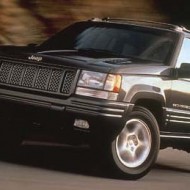
To begin: I know I didn’t post much last week. There’s a reason for that: I took a five-day trip to Charleston, one of my favorite cities, and my hotel overlooked a drawbridge. As a result, I simply sat on the balcony and excitedly watched the bridge go up and down. This left little time to post here.
Fortunately, I’m going to remedy that today with a new “it exists” piece about one of my favorite subtly cool vehicles: the 1998 Jeep Grand Cherokee 5.9 Limited. This one is so subtle I actually completely forgot about it until I received a suggestion from a reader to write it up.
Let’s start with the basics. The first-gen Grand Cherokee came out in 1993 as a replacement for the Grand Wagoneer that we all loved, unless we drove one. In 1996, it was heavily facelifted, and in 1999 it was redesigned altogether. But there were several unique special editions along the way, of which the coolest was by far the 5.9 Limited.
The 5.9 Limited was a 1998-only model that served as the SUV’s top-range trim. It had a few luxury items that boosted its stature above the regular Limited, but most importantly, it had a new powerplant: 5.9-liter V8. Aside from the SRT models, this remains the largest engine to ever go in a Grand Cherokee.
The huge V8 had 245 horsepower and 345 pound-feet, which meant the 5.9 Limited reached 60 in something like 7.3 seconds. Considering this was a time when the top-end Audi A6 had 172 horsepower, that was lightning.
Aside from its engine, the best part about the 5.9 Limited was its subtle styling upgrades. Namely: it had unique five-spoke wheels and very cool hood louvers. It also had very subtle mesh grille inserts, which are tremendously hard to spot unless you’re the most pedantic car lover in history. (In other words: me.)
Of course, the 5.9 Limited guzzled gas, which is probably why Jeep didn’t bother bringing it back on the next generation Grand Cherokee. But thanks to its short model run and minor detail differences, the 5.9 Limited is still among my favorite Grand Cherokees.
1991-1994 Nissan Sentra SE-R: It Exists
Posted by Doug DeMuro in It Exists on | 14 comments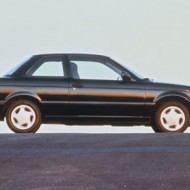
As I was angrily berated yesterday for saying the Infiniti G20 was based on the Nissan Sentra, I decided to devote today’s post to the car that shared its engine – but not its platform – with the G20: the 1991-1994 Nissan Sentra SE-R.
To create the Sentra SE-R, Nissan started with its base-level Nissan Sentra, which was a highly dull compact car with a 110-horsepower four-cylinder engine. It wasn’t just dull in terms of performance: its styling is actually nondescript, to the point where attempting to describe it just results in saying things like “slightly rounder than the previous model.”
Sensing this, Nissan decided to add a little spice to the two-door Sentra in the form of a performance model called the Sentra SE-R. Although this only resulted in a horsepower increase from 110 to 140, that was more than enough – the two-door Sentra only weighed 2,300 pounds. The power bump made the SE-R a veritable rocket ship, reaching 60 mph in around seven seconds. At the time, this was big news, since the Ferrari 348 wasn’t much faster – and it only reached 60 if the driver was wearing a white suit jacket.
The Sentra SE-R also did its best to correct the regular Sentra’s dull styling. That meant a rear spoiler, a cooler front air dam, and some alloy wheels. The wheels weren’t very sporty, but hey – at least they weren’t hubcaps.
Both the third-generation Sentra and its SE-R variant died after the 1994 model year. The next Sentra was larger and less bland, but performance wasn’t the same – even if you sprung for the two-door 200SX SE-R.
These days, it’s impossible to find a ’91-’94 Sentra SE-R in decent shape. A G20 might suffice in a pinch. Just remember: it’s not the same platform. Really.
